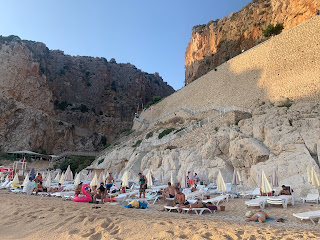A short video of my trip, now in HD!
Earlier this month I took a trip to the beautiful town of Kaş, located in the Antalya province. Surrounded by the Mediterranean Sea on the south, and the Taurus mountains in other directions, Kaş is one of a kind exotic destination. The town is home to some of the best Mediterranean beaches, including the Kaputaş and Patara beaches, and offers a rich insight into the ancient Lycian civilization. On the western edge of Kaş, overlooking the Mediterranean is the ancient Antiphellos theatre, built to accommodate up to 4000 spectators (⅓ of the city population). The theatre is dated back to 200/300 BC and was restored in the 2nd century AD after much of the region was struck by an earthquake in AD 141. The theatre is built of limestone with ashlar masonry, Lycian monuments are rather remarkable if you take a closer look. Much of the koilon (auditorium) is still intact but there are no remains of the skene.
 |
The Antiphellos theatre. You can get an exquisite view of the Mediterranean from the top, I had no strength left to climb!
|
The Lycian sarcophagi found at various locations in the city are indeed a work of art. Like in most ancient civilizations, tombs were venerated by the Lycians. Lycian tombs can range from simple rock tombs, for the poor, to intricate sarcophagi and temple tombs for the rich. The sarcophagi consist of three parts: a lower burial chamber or hyposorium with Lycian inscription, a base, and a top with a pointed arch lid. Inscriptions on the sarcophagi are burial rights which suggest that the tombs were built while the person to be buried was still alive. The Lycians inscribed their tombs to protect them from theft or damage, the inscriptions stated the punishment or fine that must be paid if the tomb is violated and cursed the desecrator.
Sunset at the Kaputaş beach.
Kekova
Located between the towns of Kaş and Demre (Lycian city of Myra, the hometown of Saint Nicholas), is the Kekova region. Full-day boat trips leave for Kekova every morning from Kaş. The Kekova region comprises of the Kekova Island, the villages of Kaleköy (Lycian Simena) and Üçağız (Lycian Teimussa), and some other small towns. The Kekova Island is uninhabited and was declared a Specially Protected Area by the Turkish government in 1990 in efforts to preserve the remains of the sunken city. On the northern shore of the Island, ruins of a sunken city are visible. These ruins belong to the Dolchiste, an ancient Lycian settlement which was destroyed and partly submerged during the earthquake in 2nd century AD. Swimming is restricted in the sunken city but it is accessible by boats and kayaks. Luckily, much of the ruins aren’t deeply submerged and are visible from the clear turquoise water. Most boats will also have glass-bottom panels allowing for a better view of the ruins which include houses, tombs, cisterns, and a harbor.
 |
| Remains of houses. |
 |
| Closer look at some underwater ruins. |
 |
| A cross can be seen carved on the city remains, probably from the Byzantine period. |
 |
| The water system and the water well. |
 |
Boats anchor at the nearby Tersane bay allowing tourists to swim close to the sunken city.
Past the sunken city is the village of Kaleköy, known for its Byzantine castle built upon some Lycian foundations including a small amphitheatre. Several Lycian tombs can be seen scattered across the village. This small village will captivate you with its quaint beauty: terracotta roofs, cobbled streets, artifacts from the Lycian, Roman, and the Ottoman periods, wild thyme and fruit trees, handmade crafts, and stunning views of the Mediterranean and the Kekova Island.
Further north from Kaleköy is the Üçağız village with more tombs and Byzantine artifacts. You can find some picturesque waterside restaurants serving fresh seafood. Üçağız village can be reached by road from Demre but Kaleköy is only accessible through water.
|
Views of the Kekova Island from Kaleköy (Left). A small cafe overlooking the Kekova Island (Right).

Handmade crafts and textiles at the village.

Fresh goat milk ice cream (right). The Simena Castle (left).
 |
| Üçağız village. A waterside restaurant and the green and white minaret of the Üçağız Cami (mosque) can be seen. |
 |
| Remains of a large necropolis on the eastern end of Üçağız. |






























